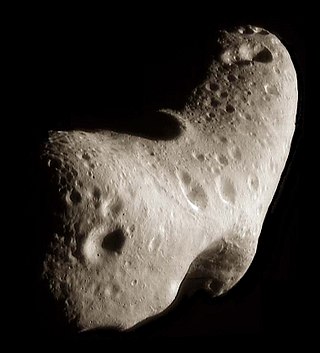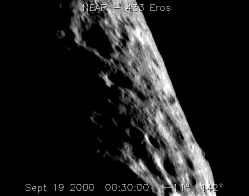(433) Eros
|
Asteroid (433) Eros |
|
|---|---|
| NEAR image of Eros with Himeros crater (right) | |
| Properties of the orbit ( animation ) | |
| Orbit type | Near-Earth asteroid, Cupid-type |
| Major semi-axis | 1.458 AU |
| eccentricity | 0.223 |
| Perihelion - aphelion | 1.133 AU - 1.783 AU |
| Inclination of the orbit plane | 10.8 ° |
| Length of the ascending node | 304.4 ° |
| Argument of the periapsis | 178.8 ° |
| Time of passage of the perihelion | April 14, 2010 |
| Sidereal period | 1 a 278 d |
| Mean orbital velocity | 24.4 km / s |
| Physical Properties | |
| Medium diameter | 34.4 × 11.2 × 11.2 km |
| Dimensions | 6.687 x 10 15 kg |
| Albedo | 0.2500 |
| Medium density | 2.67 g / cm³ |
| Rotation period | 5 h 16 min |
| Absolute brightness | 11.16 mag |
| Spectral class | S. |
| history | |
| Explorer | Gustav Witt |
| Date of discovery | August 13, 1898 |
| Another name | 1898 DQ |
| Source: Unless otherwise stated, the data comes from JPL Small-Body Database Browser . The affiliation to an asteroid family is automatically determined from the AstDyS-2 database . Please also note the note on asteroid items. | |
(433) Eros is an asteroid that was discovered on August 13, 1898 by the German astronomer Gustav Witt . It was the first known near-Earth asteroid and was used in 1900 and 1930 to precisely determine the Earth's orbit radius , analogous to Venus transits .
The heavenly body was named after Eros , the god of love from Greek mythology . The Eros Glacier on Alexander I Island in Antarctica was named after the asteroid . Because the minor planet was the first asteroid discovery that is not a member of the main belt , it was the first to be given a male name.
Eros is the first asteroid that a spacecraft orbited and landed on: NEAR Shoemaker in the years 2000 to 2001.
discovery
The asteroid was discovered on a photo plate that Gustav Witt and his assistant Felix Linke (1879-1959) had exposed on the night of August 13, 1898 at the Berlin Urania observatory . Also Auguste Charlois at Nice had taken the asteroid on the same night; at first he did not recognize the trail the asteroid had left on the photo plate.
train
Eros was the first known asteroid whose orbit is partially within the orbit of Mars . It therefore belongs to the class of low-Earth planets of the Cupid type . It orbits the sun in just 1.76 years at a distance between 1.133 ( perihelion ) and 1.783 ( aphelion ) astronomical units , so that it can come close to the earth to up to 22 million km over the course of decades. The orbit plane is inclined by 10.83 ° to the ecliptic , the orbital eccentricity is 0.223.
Soon after the discovery of the asteroid, Egon von Oppolzer noticed its strongly fluctuating brightness, from which one could deduce the duration of the rotation and an extremely elongated shape. Model calculations from the 1960s resulted in dimensions of approx. 15 km × 30 km, which came as close as 2 to 3 km to the measurements of the NEAR space probe in 2001.
In 1999 the Viennese astronomer Rudolf Dvorak published the results of his long-term numerical projections. Accordingly, Eros will remain on a relatively stable orbit for 20 million years, but then crash into the sun due to chaotic orbit disturbances .
rotation
Eros rotates around its own axis in around 5 hours and 16 minutes. The axis of rotation corresponds to one of the smallest body axes; the largest body axis also corresponds to the largest equatorial diameter.
construction
Eros is an irregularly shaped heavenly body with dimensions of 34 × 11 × 11 kilometers. It has a relatively light-colored, silicate-containing surface with a mean albedo of 0.16 (or 0.25 according to JPL data). Its density of 2.67 g / cm³ corresponds roughly to the density of silicate rock.
Temperatures on the sun-facing side (day side) of the asteroid rise to 100 ° C, while on the night side they drop to −150 ° C. During opposition it reaches a brightness of 8.3 mag . Eros was intensively investigated by the NEAR Shoemaker spacecraft from February 14, 2000 to February 12, 2001 . This had been brought into orbit around the asteroid and finally landed on its surface, whereby detailed images were created; the images show a surface strewn with craters and riddled with grooves and crevices. The asteroid was obviously exposed to violent collisions with other celestial bodies. Rock debris is lying around almost everywhere, some of which can be assigned to the impact craters. By far the largest crater has a diameter of 10 km, which corresponds to a complete narrow side of the asteroid, and bears the name Himeros. Two years before it was officially named, the NEAR Shoemaker space probe landed in its southern vicinity. The first names for surface features on Eros were given in 2003.
According to scientists on the NEAR mission, most of the larger boulders came from a crater that was probably formed in a collision a billion years ago. This impact could also be responsible for a region strewn with small craters less than 500 m in diameter, which makes up 40% of the surface of the Eros. A large part of the surface is covered with fine dust, the regolith . Originally, therefore, it was assumed that the ejection from the collision filled the smaller craters. An analysis of the crater density of the surface shows, however, that areas with fewer craters are distributed within 9 km of the point of impact. Some of the less cratered areas are on the opposite side of the impact, but are still within 9 km. It is therefore believed that when it hit, earthquake waves propagated through the asteroid and leveled the smaller craters.
Analyzes show that Eros is very likely an original monolith that was broken into several pieces by large impacts, which are mainly still held together by gravity. This is supported by global and regional fractures, rifts and ridges.
During the flyby the probe was slightly deflected by the gravity of the minor planet , from which its mass was determined to be approx. 7.2 × 10 15 kg . Because of its irregular shape, the acceleration of gravity on Eros varies greatly between different points on the surface; On average, its gravitational pull is only around 0.06 percent of that on the earth's surface. Nevertheless, rubble could apparently slide down the crater walls . The scientists suspect that the cause is vibrations in the asteroid body, which are triggered by the impact of smaller chunks and lead to reduced sliding friction .
composition
Like chondrites, Eros contains a relatively large number of metals ( iron 24 ± 5%, magnesium , nickel , aluminum , but also gold and platinum ). It is particularly similar to the L and LL chondrites, but the accuracy of the surface examination using the gamma ray spectrometer of the NEAR probe does not allow an exact assignment, especially since the surface layer relevant for this is weathered.
Various speculations have been made about the use of metal ores from eros, including a. however, the gold content is only around 0.1 ppm , which is significantly less than in gold mines on earth (1… 10 ppm).
See also
Web links
Individual evidence
- ↑ Dirk Lorenzen: The first asteroid outside the main belt. Gustav Witt and Eros. October 28, 2016. Retrieved June 4, 2017.
- ^ H. Scholl, Lutz D. Schmadel: Discovery Circumstances of the First Near-Earth Asteroid (433) Eros . In: Acta Historica Astronomiae , Vol. 15, pp. 210–220 bibcode : 2002AcHA ... 15..210S
- ↑ Egon von Oppolzer: Note on the planet (433) Eros . In: Astronomische Nachrichten, Volume 154 (1901), p. 297, doi : 10.1002 / asna.19001541413
- ^ R. Dvorak: The long term evolution of Atens and Apollos . In: Evolution and source regions of asteroids and comets: proceedings of the 173rd colloquium of the International Astronomical Union, held in Tatranska Lomnica, Slovak Republic, August 24-28, 1998 / edited by J. Svoren, EM Pittich, H. Rickman. Tatranska Lomnica, Slovak Republic: Astronomical Institute of the Slovak Academy of Sciences . 1999, p. 59–75, especially page 65 , bibcode : 1999esra.conf ... 59D .
- ↑ NASA / JPL / JHUAPL: PIA03112: A Road map for Eros. February 17, 2001, accessed June 5, 2001.
- ↑ (433) Eros in the Small-Body Database of the Jet Propulsion Laboratory (English). (Period: September 4th 2017)
- ↑ Eros: Crater, craters. ( Memento from January 17, 2017 in the Internet Archive ) In the Gazetteer of Planetary Nomenclature of the IAU (WGPSN) / USGS ; accessed on May 27, 2017.
- ↑ Spaceflight Now: Touchdown on Eros. February 12, 2001. Retrieved May 27, 2017.
- ↑ NASA / JPL / JHUAPL: PIA03142: NEAR Shoemaker's Path. February 17, 2001. Retrieved May 27, 2017.
- ↑ PC Thomas, MS Robinson: Seismic resurfacing by a single impact on the asteroid 433 Eros . In: Nature , Vol. 436 (7049), pp. 366-369, PMID 16034412
- ↑ Axel Orth: Adventure Eros. November 27, 2004, accessed June 4, 2017.
- ↑ a b Patrick N. Peplowski: First results from the NEAR gamma-ray spectrometer orbital dataset , in Planetary and Space Science , Volume 134, December 1, 2016, pages 36-51, accessed on May 24, 2019 www.sciencedirect.com reader.elsevier.com
- ^ David Whitehouse: Gold rush in space? July 22, 1999, accessed May 22, 2010 (BBC News Online).
- ↑ https://www.quora.com/Is-there-really-gold-on-asteroid-Eros Forum thread: Is there really gold on asteroid Eros? , accessed on May 24, 2019



